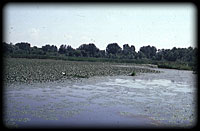 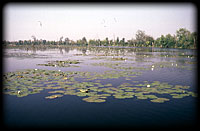 By damming up the section between Kisköre and Tiszavalk, Tisza Lake has been made within the forebank of the Tisza, which with its 127 km2 extension has become the secound largest stagnant water of the Carpathian basin. Damming was enabled by putting the Kisköre barrage into operation in 1973. The form of the recent image of the Tisza Lake is the result of a longer process, in consequence of this water spaces differring sharply from each other in habit, hydrological and hydrobiological features have been created. Considering Tisza Lake as a whole from ecological point of view it can be classified as a shallow-lake type reservoir, but its large scale mosaicity is well represented by marshes, shallow-lakes, water pits excavated by floods, large and medium sized small water courses of the level of the common bream (Abramis brama). As a result of damming, bed conditions of the area have transformed significantly; filling up is considerable, and bed material has also been changed. Since flooding the proportion of macrophyte vegetation within the reservoir is gradually growing in comparison with open water surface. Currently about 55 % of the total reservoir surface is covered by plants. In waterweed vegetation of the reservoir water chestnut (Trapa natans), and in the marsh vegetation reed (Phragmites australis) is stand forming. Among marsh plants out of this lesser bulrush and cattail(Typha angustifolia and T. latifolia, respectively) and reed sweet-grass (Glyceria maxima) are typical. In case of waterweeds beside water chestnut the spreading of other aquatic plants is not definitive, but stands of fringed water-lily (Nymphoidetum peltatae) and white water-lily (Nymphaeetum albo-luteae) are worthy of attention. By damming up the section between Kisköre and Tiszavalk, Tisza Lake has been made within the forebank of the Tisza, which with its 127 km2 extension has become the secound largest stagnant water of the Carpathian basin. Damming was enabled by putting the Kisköre barrage into operation in 1973. The form of the recent image of the Tisza Lake is the result of a longer process, in consequence of this water spaces differring sharply from each other in habit, hydrological and hydrobiological features have been created. Considering Tisza Lake as a whole from ecological point of view it can be classified as a shallow-lake type reservoir, but its large scale mosaicity is well represented by marshes, shallow-lakes, water pits excavated by floods, large and medium sized small water courses of the level of the common bream (Abramis brama). As a result of damming, bed conditions of the area have transformed significantly; filling up is considerable, and bed material has also been changed. Since flooding the proportion of macrophyte vegetation within the reservoir is gradually growing in comparison with open water surface. Currently about 55 % of the total reservoir surface is covered by plants. In waterweed vegetation of the reservoir water chestnut (Trapa natans), and in the marsh vegetation reed (Phragmites australis) is stand forming. Among marsh plants out of this lesser bulrush and cattail(Typha angustifolia and T. latifolia, respectively) and reed sweet-grass (Glyceria maxima) are typical. In case of waterweeds beside water chestnut the spreading of other aquatic plants is not definitive, but stands of fringed water-lily (Nymphoidetum peltatae) and white water-lily (Nymphaeetum albo-luteae) are worthy of attention.
|
|
Changes of environmental conditions causes qualitative and quantitative changes of planctonic and benthonic beings. Because in the Tisza the concentration of plant nutrients is high, main limitation factor of phytoplancton is temperature and floating material content. Annual changes can be linked to floods. During the flood low number of species and individuals are characteristic with dominance of diatomes, while in fall time even stagnant water elements get into the river from the forebank. Proportion of green algae increases while damming. Globally relatively stable and variable phytoplancton, rich in species, is characteristic to the reservoir space. Within certain basins, because of different environmental conditions, stands of different quantity and quality can be found. In this the proportion of open water surface and plant cover, water depth and exposition are definitive.
|
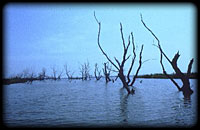 Zooplancton stand of dammed Tisza in consequence of capricious changes in water level is very changeable. In flood time low number of species and individuals is typical. In summer the composition of the river's zooplancton is similar to that of large stagnant water basins of the reservoir both in number of species and individuals. In the reservoir number of wheel animalcules (Rotatoria) and small crustaceans (Cladocera, Copepoda) together show the characteristic composition in species of shallow aquatic ecosystems. Zooplancton stand of dammed Tisza in consequence of capricious changes in water level is very changeable. In flood time low number of species and individuals is typical. In summer the composition of the river's zooplancton is similar to that of large stagnant water basins of the reservoir both in number of species and individuals. In the reservoir number of wheel animalcules (Rotatoria) and small crustaceans (Cladocera, Copepoda) together show the characteristic composition in species of shallow aquatic ecosystems.
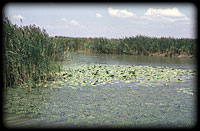 In certain basins within close water spaces made by macrophyte plant stands, a mosaical zooplancton stand forms. This mosaicity decreases in flood periods. As an effect of successive processes euplanctonic elements will be dominant in deeper water spaces (Abádszalók -bay, part of the Poroszló-basin), and on areas directly influenced by rinse channels. On more closed areas with shallow water, bacoming marshy members of species living between plants (metafiton) and sediment-fauna are dominant. In certain basins within close water spaces made by macrophyte plant stands, a mosaical zooplancton stand forms. This mosaicity decreases in flood periods. As an effect of successive processes euplanctonic elements will be dominant in deeper water spaces (Abádszalók -bay, part of the Poroszló-basin), and on areas directly influenced by rinse channels. On more closed areas with shallow water, bacoming marshy members of species living between plants (metafiton) and sediment-fauna are dominant.
|
|
Benthonic fauna of the reservoir can be called medium rich in whole. Dominance of stagnant water fauna is typical. Similarly to zooplancton here too differences can be experienced in quantitative and qualitative relations of stands of certain basins. In closer areas covered by plants biomass content is slightly higher, but due to becoming marshy, annelids (Oligochaeta) and larvae of midges (Chironomidae), tolerating extreme low oxygen content are present in larger proportion.
|
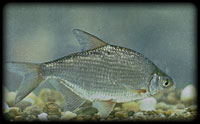 Changes ensued by the effect of dumming storing at Kisköre have transformed the fish stockof the course between Tisza Kisköre and Tiszabábolna to a great extent. In whole decrease of number of species and individuals of riverine fauna is typical. Through damming, or rather through flooding however, a habitat complex forms, differring from the previous in character and more diverse in many respects, the conditions of which are favourable on one hand for reproduction of limnophilous species of the level, and on the other hand they promote primary and secoundary production, so increasing fish biomass too. By the overall picture of the fish fauna, the river course falling on the territory of the reservoir belongs to the lower section of the bream zone, its nature consercation value is given by fish communities uniquely diverse in composition, formed by the high degree mosaicity of the reservoir. According to environmental conditions the fish fauna of Changes ensued by the effect of dumming storing at Kisköre have transformed the fish stockof the course between Tisza Kisköre and Tiszabábolna to a great extent. In whole decrease of number of species and individuals of riverine fauna is typical. Through damming, or rather through flooding however, a habitat complex forms, differring from the previous in character and more diverse in many respects, the conditions of which are favourable on one hand for reproduction of limnophilous species of the level, and on the other hand they promote primary and secoundary production, so increasing fish biomass too. By the overall picture of the fish fauna, the river course falling on the territory of the reservoir belongs to the lower section of the bream zone, its nature consercation value is given by fish communities uniquely diverse in composition, formed by the high degree mosaicity of the reservoir. According to environmental conditions the fish fauna of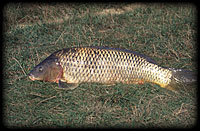 the river bed, the reservoir space and dead beds within the reservoir space differ from each other. In the dammed river bed most frequent species are silver bream (Blicca bjoerkna), common bream (Abremis brama), gibel carp (Carassius auratus gibelio), among economically important species carp (Cyprinus carpio), pikeperch (Stizostedion lucioperca), wels (Silurus glanis) and pike (Esox lucius) are frequent. Higher number of species is due to sparse rheophilous species, which make the fauna of the area colourful still today. Number of species in the reservoir space and in dead beds is lower, here dominant species are limnophilous ones adapted to stagnant water conditions, such as common bream (Abramis brama), betterling (Rhodeus sericeus amarus), black bullhead (Ictalurus melas), umpkinseed (Lepomis gibbosus), ... (Proterorhinus marmoratus), among carnivores beside pike (Esox lucius) and pikeperch (Stizostedion lucioperca) asp (Aspius aspius)is quite frequent. Within closer waters of dead beds the proportion of species linking to plant communities the river bed, the reservoir space and dead beds within the reservoir space differ from each other. In the dammed river bed most frequent species are silver bream (Blicca bjoerkna), common bream (Abremis brama), gibel carp (Carassius auratus gibelio), among economically important species carp (Cyprinus carpio), pikeperch (Stizostedion lucioperca), wels (Silurus glanis) and pike (Esox lucius) are frequent. Higher number of species is due to sparse rheophilous species, which make the fauna of the area colourful still today. Number of species in the reservoir space and in dead beds is lower, here dominant species are limnophilous ones adapted to stagnant water conditions, such as common bream (Abramis brama), betterling (Rhodeus sericeus amarus), black bullhead (Ictalurus melas), umpkinseed (Lepomis gibbosus), ... (Proterorhinus marmoratus), among carnivores beside pike (Esox lucius) and pikeperch (Stizostedion lucioperca) asp (Aspius aspius)is quite frequent. Within closer waters of dead beds the proportion of species linking to plant communities 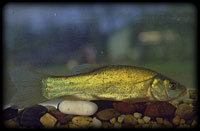 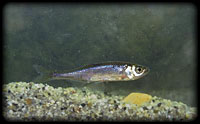 is prominent, such as betterling (Rhodeus sericeus amarus), rudd (Scardinius erythrophthalmus), perch (Perca fluviatilis) and the proportion of stagnpohilous species as tench (Tinca tinca), crucian carp (Carassius carassius), gibel carp (Carassius auratus gibelio), mud loach (Misgurnus fossilis), spined loach (Cobitis taenia), moderlieschen (Leucaspius delineatus), European mudminnow (Umbra krameri) is also higher here. is prominent, such as betterling (Rhodeus sericeus amarus), rudd (Scardinius erythrophthalmus), perch (Perca fluviatilis) and the proportion of stagnpohilous species as tench (Tinca tinca), crucian carp (Carassius carassius), gibel carp (Carassius auratus gibelio), mud loach (Misgurnus fossilis), spined loach (Cobitis taenia), moderlieschen (Leucaspius delineatus), European mudminnow (Umbra krameri) is also higher here.
|
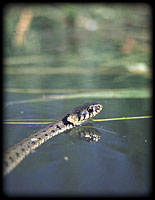 Shallow water or temporary water covered areas of Tisza Lake are authentic habitats of amphibians, very abundant in individuals of species of edible frog complex (Rana spp.), brown toad (Bufo bufo), tree-frog (Hyla arborea), bombinator (Bombina bombina). Among reptiles considerable stocks of common European water snake (Natrix natrix) and European pond turtle (Emys orbicularis) can be found here. Shallow water or temporary water covered areas of Tisza Lake are authentic habitats of amphibians, very abundant in individuals of species of edible frog complex (Rana spp.), brown toad (Bufo bufo), tree-frog (Hyla arborea), bombinator (Bombina bombina). Among reptiles considerable stocks of common European water snake (Natrix natrix) and European pond turtle (Emys orbicularis) can be found here.
|
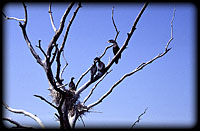 Among birds on the territory of the reservoir brooding of mixed heron colonies is important. Nesting of pygmy cormorant (Phalacrocorax pygmaeus) is prominent. Tisza Lake and its environs is an important resting and feeding place of migratory birds. In spring and autumn migration of birds goos and duch migration is particular. Among birds on the territory of the reservoir brooding of mixed heron colonies is important. Nesting of pygmy cormorant (Phalacrocorax pygmaeus) is prominent. Tisza Lake and its environs is an important resting and feeding place of migratory birds. In spring and autumn migration of birds goos and duch migration is particular.
|
|
The most valuable member of mammal fauna is beaver (Castor fiber), resettled about one decade ago and forming stable population, and otter (Lutra lutra) present everywhere.
|

 By damming up the section between Kisköre and Tiszavalk, Tisza Lake has been made within the forebank of the Tisza, which with its 127 km2 extension has become the secound largest stagnant water of the Carpathian basin. Damming was enabled by putting the Kisköre barrage into operation in 1973. The form of the recent image of the Tisza Lake is the result of a longer process, in consequence of this water spaces differring sharply from each other in habit, hydrological and hydrobiological features have been created. Considering Tisza Lake as a whole from ecological point of view it can be classified as a shallow-lake type reservoir, but its large scale mosaicity is well represented by marshes, shallow-lakes, water pits excavated by floods, large and medium sized small water courses of the level of the common bream (Abramis brama). As a result of damming, bed conditions of the area have transformed significantly; filling up is considerable, and bed material has also been changed. Since flooding the proportion of macrophyte vegetation within the reservoir is gradually growing in comparison with open water surface. Currently about 55 % of the total reservoir surface is covered by plants. In waterweed vegetation of the reservoir water chestnut (Trapa natans), and in the marsh vegetation reed (Phragmites australis) is stand forming. Among marsh plants out of this lesser bulrush and cattail(Typha angustifolia and T. latifolia, respectively) and reed sweet-grass (Glyceria maxima) are typical. In case of waterweeds beside water chestnut the spreading of other aquatic plants is not definitive, but stands of fringed water-lily (Nymphoidetum peltatae) and white water-lily (Nymphaeetum albo-luteae) are worthy of attention.
By damming up the section between Kisköre and Tiszavalk, Tisza Lake has been made within the forebank of the Tisza, which with its 127 km2 extension has become the secound largest stagnant water of the Carpathian basin. Damming was enabled by putting the Kisköre barrage into operation in 1973. The form of the recent image of the Tisza Lake is the result of a longer process, in consequence of this water spaces differring sharply from each other in habit, hydrological and hydrobiological features have been created. Considering Tisza Lake as a whole from ecological point of view it can be classified as a shallow-lake type reservoir, but its large scale mosaicity is well represented by marshes, shallow-lakes, water pits excavated by floods, large and medium sized small water courses of the level of the common bream (Abramis brama). As a result of damming, bed conditions of the area have transformed significantly; filling up is considerable, and bed material has also been changed. Since flooding the proportion of macrophyte vegetation within the reservoir is gradually growing in comparison with open water surface. Currently about 55 % of the total reservoir surface is covered by plants. In waterweed vegetation of the reservoir water chestnut (Trapa natans), and in the marsh vegetation reed (Phragmites australis) is stand forming. Among marsh plants out of this lesser bulrush and cattail(Typha angustifolia and T. latifolia, respectively) and reed sweet-grass (Glyceria maxima) are typical. In case of waterweeds beside water chestnut the spreading of other aquatic plants is not definitive, but stands of fringed water-lily (Nymphoidetum peltatae) and white water-lily (Nymphaeetum albo-luteae) are worthy of attention.
 Zooplancton stand of dammed Tisza in consequence of capricious changes in water level is very changeable. In flood time low number of species and individuals is typical. In summer the composition of the river's zooplancton is similar to that of large stagnant water basins of the reservoir both in number of species and individuals. In the reservoir number of wheel animalcules (Rotatoria) and small crustaceans (Cladocera, Copepoda) together show the characteristic composition in species of shallow aquatic ecosystems.
Zooplancton stand of dammed Tisza in consequence of capricious changes in water level is very changeable. In flood time low number of species and individuals is typical. In summer the composition of the river's zooplancton is similar to that of large stagnant water basins of the reservoir both in number of species and individuals. In the reservoir number of wheel animalcules (Rotatoria) and small crustaceans (Cladocera, Copepoda) together show the characteristic composition in species of shallow aquatic ecosystems.
 In certain basins within close water spaces made by macrophyte plant stands, a mosaical zooplancton stand forms. This mosaicity decreases in flood periods. As an effect of successive processes euplanctonic elements will be dominant in deeper water spaces (Abádszalók -bay, part of the Poroszló-basin), and on areas directly influenced by rinse channels. On more closed areas with shallow water, bacoming marshy members of species living between plants (metafiton) and sediment-fauna are dominant.
In certain basins within close water spaces made by macrophyte plant stands, a mosaical zooplancton stand forms. This mosaicity decreases in flood periods. As an effect of successive processes euplanctonic elements will be dominant in deeper water spaces (Abádszalók -bay, part of the Poroszló-basin), and on areas directly influenced by rinse channels. On more closed areas with shallow water, bacoming marshy members of species living between plants (metafiton) and sediment-fauna are dominant.
 Changes ensued by the effect of dumming storing at Kisköre have transformed the fish stockof the course between Tisza Kisköre and Tiszabábolna to a great extent. In whole decrease of number of species and individuals of riverine fauna is typical. Through damming, or rather through flooding however, a habitat complex forms, differring from the previous in character and more diverse in many respects, the conditions of which are favourable on one hand for reproduction of limnophilous species of the level, and on the other hand they promote primary and secoundary production, so increasing fish biomass too. By the overall picture of the fish fauna, the river course falling on the territory of the reservoir belongs to the lower section of the bream zone, its nature consercation value is given by fish communities uniquely diverse in composition, formed by the high degree mosaicity of the reservoir. According to environmental conditions the fish fauna of
Changes ensued by the effect of dumming storing at Kisköre have transformed the fish stockof the course between Tisza Kisköre and Tiszabábolna to a great extent. In whole decrease of number of species and individuals of riverine fauna is typical. Through damming, or rather through flooding however, a habitat complex forms, differring from the previous in character and more diverse in many respects, the conditions of which are favourable on one hand for reproduction of limnophilous species of the level, and on the other hand they promote primary and secoundary production, so increasing fish biomass too. By the overall picture of the fish fauna, the river course falling on the territory of the reservoir belongs to the lower section of the bream zone, its nature consercation value is given by fish communities uniquely diverse in composition, formed by the high degree mosaicity of the reservoir. According to environmental conditions the fish fauna of the river bed, the reservoir space and dead beds within the reservoir space differ from each other. In the dammed river bed most frequent species are silver bream (Blicca bjoerkna), common bream (Abremis brama), gibel carp (Carassius auratus gibelio), among economically important species carp (Cyprinus carpio), pikeperch (Stizostedion lucioperca), wels (Silurus glanis) and pike (Esox lucius) are frequent. Higher number of species is due to sparse rheophilous species, which make the fauna of the area colourful still today. Number of species in the reservoir space and in dead beds is lower, here dominant species are limnophilous ones adapted to stagnant water conditions, such as common bream (Abramis brama), betterling (Rhodeus sericeus amarus), black bullhead (Ictalurus melas), umpkinseed (Lepomis gibbosus), ... (Proterorhinus marmoratus), among carnivores beside pike (Esox lucius) and pikeperch (Stizostedion lucioperca) asp (Aspius aspius)is quite frequent. Within closer waters of dead beds the proportion of species linking to plant communities
the river bed, the reservoir space and dead beds within the reservoir space differ from each other. In the dammed river bed most frequent species are silver bream (Blicca bjoerkna), common bream (Abremis brama), gibel carp (Carassius auratus gibelio), among economically important species carp (Cyprinus carpio), pikeperch (Stizostedion lucioperca), wels (Silurus glanis) and pike (Esox lucius) are frequent. Higher number of species is due to sparse rheophilous species, which make the fauna of the area colourful still today. Number of species in the reservoir space and in dead beds is lower, here dominant species are limnophilous ones adapted to stagnant water conditions, such as common bream (Abramis brama), betterling (Rhodeus sericeus amarus), black bullhead (Ictalurus melas), umpkinseed (Lepomis gibbosus), ... (Proterorhinus marmoratus), among carnivores beside pike (Esox lucius) and pikeperch (Stizostedion lucioperca) asp (Aspius aspius)is quite frequent. Within closer waters of dead beds the proportion of species linking to plant communities 
 is prominent, such as betterling (Rhodeus sericeus amarus), rudd (Scardinius erythrophthalmus), perch (Perca fluviatilis) and the proportion of stagnpohilous species as tench (Tinca tinca), crucian carp (Carassius carassius), gibel carp (Carassius auratus gibelio), mud loach (Misgurnus fossilis), spined loach (Cobitis taenia), moderlieschen (Leucaspius delineatus), European mudminnow (Umbra krameri) is also higher here.
is prominent, such as betterling (Rhodeus sericeus amarus), rudd (Scardinius erythrophthalmus), perch (Perca fluviatilis) and the proportion of stagnpohilous species as tench (Tinca tinca), crucian carp (Carassius carassius), gibel carp (Carassius auratus gibelio), mud loach (Misgurnus fossilis), spined loach (Cobitis taenia), moderlieschen (Leucaspius delineatus), European mudminnow (Umbra krameri) is also higher here.
 Shallow water or temporary water covered areas of Tisza Lake are authentic habitats of amphibians, very abundant in individuals of species of edible frog complex (Rana spp.), brown toad (Bufo bufo), tree-frog (Hyla arborea), bombinator (Bombina bombina). Among reptiles considerable stocks of common European water snake (Natrix natrix) and European pond turtle (Emys orbicularis) can be found here.
Shallow water or temporary water covered areas of Tisza Lake are authentic habitats of amphibians, very abundant in individuals of species of edible frog complex (Rana spp.), brown toad (Bufo bufo), tree-frog (Hyla arborea), bombinator (Bombina bombina). Among reptiles considerable stocks of common European water snake (Natrix natrix) and European pond turtle (Emys orbicularis) can be found here.
 Among birds on the territory of the reservoir brooding of mixed heron colonies is important. Nesting of pygmy cormorant (Phalacrocorax pygmaeus) is prominent. Tisza Lake and its environs is an important resting and feeding place of migratory birds. In spring and autumn migration of birds goos and duch migration is particular.
Among birds on the territory of the reservoir brooding of mixed heron colonies is important. Nesting of pygmy cormorant (Phalacrocorax pygmaeus) is prominent. Tisza Lake and its environs is an important resting and feeding place of migratory birds. In spring and autumn migration of birds goos and duch migration is particular.